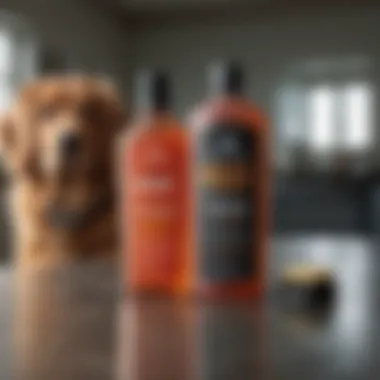The Ultimate Guide to Choosing Anti-Flea Dog Shampoo


Intro
Selecting the right anti-flea dog shampoo is a crucial aspect of pet care. Fleas are not just a nuisance; they can cause severe health problems for dogs, including skin diseases and allergies. Understanding the nuances of flea treatments can empower you to make informed decisions that benefit your furry friend and your home. This guide aims to provide a comprehensive overview of how to choose the best anti-flea dog shampoo, touching upon its effectiveness, key ingredients, and addressing common misconceptions surrounding fleas and flea treatments.
Understanding Pests
Definition of Pests
Pests are organisms that can cause harm to animals, humans, and their environment. Specifically, fleas are small, wingless insects that feed on the blood of their host, primarily dogs and cats. Infestations can arise swiftly, leading to irritation and discomfort for your pet. Fleas can reproduce quickly, making timely intervention critical.
Importance of Pest Identification
Identifying the type of pest affecting your pet is vital for effective treatment. Not all products are suitable for every type of pest. Different fleas may require distinct methods of control. You should observe your pet for signs of fleas, including excessive scratching, bite marks, or even visible fleas in their fur. Correct identification can lead to more effective use of treatments and help prevent future infestations.
Prevention Techniques
Home and Garden Preventative Measures
Preventing flea infestations begins at home. Consider the following measures:
- Regularly vacuum carpets and any pet bedding.
- Wash pet bedding in hot water weekly.
- Trim your yard to reduce hiding places for fleas.
Also, employ some outdoor treatments, such as:
- Using flea-repelling plants like rosemary or lavender.
- Keeping your lawn well-maintained to reduce flea habitats.
Seasonal Prevention Tips
Flea activity can vary by season, so measures should change accordingly. During warmer months, increased vigilance is necessary since fleas thrive in warm environments. Products like collars and spot-on treatments can be more effective during these months.
Eco-Friendly Pest Control Solutions
Overview of Sustainable Practices
Many pet owners are increasingly concerned about the environmental impact of commercial flea treatments. Sustainable practices emphasize using less harmful solutions. This might include selecting shampoos that contain biodegradable ingredients or exploring integrated pest management strategies.
Natural Remedies and Their Effectiveness
Natural remedies exist and can offer alternative solutions. Some widely recognized options include:
- Diatomaceous earth: A powder that is safe for pets but lethal to fleas.
- Essential oils: Certain oils, such as peppermint or cedar, can deter fleas when used correctly.
However, care must be taken. Not all natural remedies are safe for pets, so researching ingredients carefully is important.
Understanding Fleas and Their Impact on Dogs
Fleas pose significant threats to dogs and require attention from pet owners. Understanding the dynamics of fleas is crucial in making informed decisions about their prevention and management. Fleas are not merely a nuisance; they can trigger health issues that impact a dog's quality of life. Pet owners should recognize that controlling fleas involves understanding their life cycle, health risks, and recognizing signs of infestation. This background knowledge is vital for maintaining a healthier environment for both pets and their human families.
Life Cycle of Fleas
Fleas have a complex life cycle that generally comprises four stages: egg, larva, pupa, and adult.
- Egg: Fleas begin their life cycle as eggs, which are often laid in the dog’s fur. These eggs can hatch within a week under suitable conditions.
- Larva: Once hatched, larvae emerge and continue to develop in dark, secluded areas. They thrive in the environment, feeding on organic debris and flea feces, making it crucial to maintain cleanliness.
- Pupa: After developing, the larvae spin into cocoons and enter the pupa stage. This stage can last a while and can remain dormant, waiting for favorable conditions to come out as adults.
- Adult: Once fully developed, adult fleas emerge and seek out hosts—primarily dogs and cats—to feed on. It is important to realize that a single flea can lead to an infestation, because females can lay hundreds of eggs in their lifetime.
This cyclical nature of fleas means that simply applying anti-flea treatments once may not suffice. Knowing how they reproduce may help to inform preventive measures.
Health Risks Associated with Fleas
Fleas carry multiple health risks which can range from mild annoyances to serious diseases. The most important health issues include:
- Allergic Reactions: Many dogs experience allergic reactions to flea saliva, leading to severe itching, skin rashes, and in some cases, infection due to scratching.
- Anemia: Fleas consume blood, and heavy infestations can lead to anemia, particularly in puppies or older dogs. This can be life-threatening if left untreated.
- Tapeworms: Fleas can also transmit tapeworms to dogs. When a dog ingests a flea while grooming, the tapeworm larvae can infect the dog’s intestines.
Awareness of these risks allows pet owners to take timely action, ensuring health is prioritized alongside comfort.
Signs of Flea Infestation


Identifying a flea infestation early can significantly minimize its consequences. Common signs include:
- Scratching: A dog constantly scratching or biting at its skin indicates possible flea presence.
- Flea Dirt: Dark specks in the fur or skin, known as flea dirt, are another indicator. This material is flea feces and suggests active fleas in the coat.
- Hair Loss or Skin Irritation: Patchy areas of hair loss or hot spots can result from flea bites.
Recognizing these signs is critical in preventing fleas from becoming a more severe problem. With an understanding of flea behavior, health implications, and how to spot early signs of infestation, dog owners can address these issues proactively.
The Role of Anti-Flea Shampoos
Flea management is a multifaceted challenge for dog owners. Anti-flea shampoos are a key component in this strategy. They serve not just as a reactive measure but also as a preventive tool that contributes to the overall health of your dog. Understanding the role of these shampoos is essential for effective flea control.
How Do Anti-Flea Shampoos Work?
Anti-flea shampoos primarily operate through the active ingredient that targets fleas at various stages of their life cycle. Upon application, the shampoo creates a hostile environment for adult fleas, effectively suffocating or poisoning them. Common ingredients include insecticides like pyrethrins or permethrins. These substances deactivate the flea's nervous system, leading to their quick demise.
Additionally, these shampoos often disrupt the flea's ability to lay eggs. By halting reproduction, they limit future infestations. The method of action relies heavily on proper application. Thoroughly wetting the coat and ensuring even distribution of the shampoo are crucial steps.
Benefits of Using Shampoo for Flea Control
Utilizing anti-flea shampoo offers numerous advantages:
- Immediate Control: Shampoos provide a quick solution for current infestations. They can kill existing fleas on contact, which is beneficial for immediate relief.
- Cleansing Effect: In addition to killing fleas, many shampoos help cleanse the dog's coat of dirt and debris. This can contribute to better overall skin health.
- Ease of Use: Applying shampoo can be simpler than some other treatments. The process of bathing a dog is straightforward, allowing owners to quickly treat their pets.
- Alternatives to Chemical Treatments: Some shampoos use natural ingredients. This option can be attractive for pet owners who prefer more holistic approaches.
"A good anti-flea shampoo not only kills fleas but also contributes to the dog's overall comfort and hygiene."
However, one should not rely solely on shampoos as a comprehensive solution. They perform best in conjunction with other flea control methods for sustainable management. Being aware of their limitations is crucial.
Key Ingredients in Anti-Flea Dog Shampoos
Selecting the right anti-flea shampoo involves understanding the key ingredients that make these products effective. Each component plays a role in how well the shampoo can eliminate fleas, soothe the dog’s skin, and promote overall health.
Knowing the ingredients can help pet owners make informed decisions and choose products that align with their dog's specific needs. This section will explore various categories of ingredients found in anti-flea dog shampoos, including their benefits and considerations.
Insecticidal Agents
Insecticidal agents are the primary components in anti-flea shampoos that directly target fleas at various stages of their life cycle. These ingredients work to kill adult fleas and prevent their eggs from hatching. Common insecticidal agents include permethrin, pyrethrins, and fipronil.
- Permethrin: This is a synthetic chemical that mimics natural insecticides. It is effective in killing adult fleas quickly and is often preferred for its long-lasting effects.
- Pyrethrins: Derived from chrysanthemum flowers, pyrethrins are also effective against adult fleas but are generally less potent than permethrin. They may cause skin irritation in some dogs.
- Fipronil: Often used in topical flea treatments, fipronil acts on the nervous system of insects, leading to death when contacted.
When choosing a shampoo with insecticidal agents, it is essential to consider your dog's sensitivity. Always consult with a veterinarian before use, especially if your dog is young, pregnant, or has health issues.
Natural Alternatives
For many pet owners, natural alternatives to chemical-based shampoos are appealing. These products often contain plant-derived ingredients known for their insect-repelling properties. Common natural alternatives include essential oils such as lavender, cedarwood, and eucalyptus.
- Lavender Oil: This oil is known for its calming properties, and it can help repel fleas while providing a pleasant scent.
- Cedarwood Oil: Its strong aroma acts as a deterrent for fleas and can help keep them at bay.
- Eucalyptus Oil: This oil is effective against fleas but should be used cautiously as it can cause reactions in some dogs.
While natural alternatives may be safer for some pets, their effectiveness can vary. Always check for potential allergens, and consider using these products in conjunction with other flea-control methods for better results.
Moisturizers and Soothing Agents
Moisturizers and soothing agents are crucial in anti-flea shampoos as they help alleviate any irritation or dryness caused by the insecticidal agents. Ingredients like aloe vera, oatmeal, and vitamin E can provide essential nourishment for your dog's skin.
- Aloe Vera: Well-known for its soothing properties, aloe vera can help heal and moisturize. It can significantly reduce inflammation caused by flea bites.
- Oatmeal: This ingredient is often included for its natural anti-itch properties. It can help soothe itchy skin and serve as a gentle exfoliator.
- Vitamin E: Known for its antioxidant effects, vitamin E helps in maintaining skin health and can assist in healing any damage.
Including these moisturizing agents can help balance the harsh effects of insecticides, leading to a healthier coat and skin. Always look for shampoos that state they are gentle or made for sensitive skin, especially if your dog has a history of skin issues.
"Choosing a shampoo with the right balance of ingredients can enhance the effectiveness of flea control while maintaining your dog's skin health."
Selecting the Best Anti-Flea Shampoo
Choosing the right anti-flea shampoo is critical for several reasons. Fleas are not just a nuisance; they can lead to serious health issues for dogs if not addressed properly. Therefore, selecting an effective anti-flea shampoo is more than just a grooming choice; it is an essential part of caring for your dog's health. The effectiveness of the shampoo will directly impact the wellbeing of your pet.
Here are some beneficial elements to consider when selecting an anti-flea shampoo:
- Ingredients: Understanding the components and their functions helps in making an informed decision. Knowing which ingredients are effective against fleas and which are safe for your dog is crucial.
- Dog's Health Conditions: Different dogs may have specific health needs or allergies that should influence your choice. For instance, a dog with sensitive skin requires a gentler formula.
- Frequency of Use: Consider how often you plan to bathe your dog. Certain shampoos may have residual effects that can affect the bathing schedule. It's important to align the effectiveness of the shampoo with your dog's bathing routine.


Assessing Your Dog's Specific Needs
Before purchasing anti-flea shampoo, it is vital to identify your dog's specific needs. Each dog is unique, so consider the following elements:
- Skin Sensitivity: Dogs with sensitive skin may react negatively to harsh chemicals. A shampoo with natural ingredients or specifically formulated for sensitive skin is preferable.
- Flea Infestation Severity: Assess if your dog has a severe infestation or if it is occasional. For serious situations, potent products may be necessary, while mild cases may require gentler options.
- Age and Size: Puppies have different requirements than adult dogs. Likewise, large breeds may need different dosages compared to small breeds.
Dosage and Application Guidelines
The effectiveness of an anti-flea shampoo lies not only in its formula but also in its proper usage. Follow these guidelines for effective application:
- Read Instructions: Always refer to the product label for specific instructions on dosage and application.
- Wet the Dog Thoroughly: Use lukewarm water to wet your dog's coat before applying the shampoo. This ensures even distribution.
- Apply Shampoo Generously: Make sure to use a sufficient amount to cover your dog's entire body, but avoid overly saturating.
- Massage the Shampoo: Gently work the shampoo into the coat, paying special attention to areas prone to fleas, such as behind the ears and around the tail.
- Rinse Properly: Ensure all the shampoo is washed away. Leaving residue can irritate your dog's skin and may affect their comfort.
Examining Product Labels
Product labels provide essential information that can help in making the right choice. When reading labels, focus on:
- Active Ingredients: Identify the insecticidal agents. Ensure they are proven to be effective against fleas while being safe for dogs.
- Safety Warnings: Look out for any potential risks associated with the product, especially if your dog has specific health conditions.
- Expiration Dates: Ensure the product is within the usable time frame to guarantee effectiveness.
- Usage Guidelines: Verify any specific instructions related to dosage and frequency of use to optimize results.
Popular Brands and Their Formulations
When it comes to protecting your dog from fleas, understanding the landscape of popular brands and their specific formulations is crucial. Each brand may offer unique ingredients, varying convenience, and varied target customer bases. This leads to an array of options that serve different needs. As you delve into this section, you will discover the merits and considerations that can guide you in selecting an appropriate shampoo for your pet.
Prescription vs. Over-the-Counter Products
One key distinction in the market is that between prescription and over-the-counter (OTC) products. Prescription shampoos are often more potent and tailored for specific conditions. Veterinarians typically suggest them after assessing the severity of a flea infestation on your dog. They may include stronger insecticides, which can immediately target fleas and other parasites.
OTC products, on the other hand, are readily available without a vet's approval. These shampoos often contain milder ingredients. While they may be suitable for lighter infestations or as a preventive measure, they may not effectively eliminate all fleas in severe cases. Depending on the health condition and the flea situation on your dog, one option may be preferable over the other. Pet owners must weight the potential risks and benefits, especially in regards to their dog's overall health.
Evaluating Customer Reviews
The significance of customer reviews cannot be understated. They provide valuable insights into real-world experiences with various anti-flea shampoos. Pay close attention to reviews that mention effectiveness against fleas, how the shampoo performed over time, and any side effects experienced by users.
When you assess reviews, look for consistent themes rather than isolated opinions. Here are factors to consider when browsing through customer feedback:
- Efficacy: How well did the product work? Did it show noticeable results in a reasonable timeframe?
- Skin Reactions: Did any dogs have adverse reactions to the shampoo? Look for comments on irritation or allergy symptoms.
- Ease of Application: Was the shampoo easy to apply? Did it require elaborate steps or simple instructions?
- Scent and Lather: Users often comment on product fragrance and how well it lathers. Some dogs may refuse baths if the shampoo has an unpleasant smell.
In summary, diving into customer reviews will empower you to make an informed choice. Quality feedback gives an authentic glimpse into each product’s performance, allowing you to select the best fit for your furry companions.
Technique for Shampoos Application
The technique used for applying anti-flea shampoos is crucial in determining the effectiveness of the treatment. Proper application not only maximizes the potential benefits of the product but also ensures your dog's comfort and safety during the bathing process. Incorrect techniques can lead to suboptimal results, making it essential to follow a systematic approach. This section focuses on two key aspects: preparing your dog for bathing and the steps to ensure optimal shampoo usage.
Preparing Your Dog for Bathing
Before starting the bath, it is important to prepare your dog properly. This preparation aids in reducing anxiety and ensures safety during the process. Here are some considerations:
- Choose a Suitable Environment: Ensure the bathing area is calm and non-slip. A wet floor can be hazardous, especially for smaller or older dogs.
- Gather Supplies: Before beginning, have all items ready. This includes the selected anti-flea shampoo, a cup for rinsing, towels, and possibly a brush. Being organized can ease the overall experience.
- Brush Your Dog: Brush your dog's coat to eliminate knots and loose fur. This step helps in the even distribution of shampoo and promotes better penetration of active ingredients.
- Gentle Introduction: Allow your dog to become familiar with the bathing area. Some dogs may be fearful, so a calm and soothing approach is critical. Spend a few moments letting them explore before you start.
- Check Water Temperature: Warm water is preferred, as it is generally more comfortable for dogs. Cold or hot water can cause distress, which can hinder the process.
By adequately preparing your dog and ensuring your environment is appropriate, you set the stage for an effective flea treatment.
Steps for Optimal Shampoo Usage
After preparation, the application of anti-flea shampoo should be methodical. Here are essential steps to follow:
- Wet Your Dog Thoroughly: Use warm water to wet your dog's entire coat. Ensuring that the fur is completely saturated allows for better shampoo distribution.
- Apply the Shampoo: Squeeze the recommended amount of anti-flea shampoo directly onto your dog’s back. Start at the neck and work your way down the body. This technique prevents fleas from migrating towards the head.
- Lather Gently: Use your hands or a pet bath brush to distribute the shampoo evenly. Work the product into a lather, paying extra attention to areas where fleas are likely to hide, such as around the ears, tail, and underbelly.
- Let It Sit: Allow the shampoo to sit as directed on the label. This time is essential for the active ingredients to work effectively against fleas and their eggs.
- Rinse Thoroughly: Rinse your dog thoroughly with warm water, making sure all shampoo is removed. Any residue can irritate the skin and reduce effectiveness against fleas.
- Dry Properly: Use a towel to dry your dog, helping to absorb moisture effectively. Be gentle to avoid irritating their skin.
Following these steps can enhance the efficiency of the anti-flea shampoo while ensuring your dog's comfort throughout the process. A systematic approach during application minimizes the chances of leaving behind any fleas and maximizes the shampoo's potential effectiveness.
Additional Flea Control Measures
Flea control is a multi-faceted approach. While anti-flea dog shampoos are effective, additional measures are crucial to completely eradicating fleas from your home and preventing future infestations. Applying these extra steps will not only enhance the effectiveness of the shampoo but also contribute to the overall wellness of your dog and your living environment.
Integrating Environmental Control Measures
Your home environment plays a significant role in flea infestation. Fleas thrive in warm, humid conditions, making it essential to create a hostile environment for them. To achieve this, consider the following steps:


- Regular Vacuuming: Frequent vacuuming of floors, carpets, and upholstery can eliminate flea eggs, larvae, and adult fleas. Make sure to dispose of the vacuum bag or empty the canister outside your home.
- Washing Bedding and Fabrics: Wash your dog’s bedding, toys, and any fabric items in hot water to kill any fleas or larvae. This also applies to your own bedding as fleas can easily transition between pets and humans.
- Using Environmental Sprays: Consider using flea control sprays designed for indoor use. Look for products containing ingredients like pyrethrins or insect growth regulators. Be cautious and follow the instructions closely to ensure safety for your pet and family.
By integrating these practices, you limit the habitats available for fleas, which can dramatically reduce their numbers in your home.
Importance of Regular Vet Check-ups
Regular veterinary check-ups are invaluable for maintaining your dog's health and effectively managing flea control. These visits provide an opportunity to discuss flea prevention strategies with your veterinarian, ensuring that you are well-informed on the best products and practices. During these check-ups, you can also monitor for flea-related health issues, such as dermatitis, anemia, or tapeworm infections caused by fleas.
Veterinarians may recommend:
- Flea Prevention Medications: These can be administered topically, orally, or as collar formulations. Regular use of these medications can significantly reduce the chance of flea infestations.
- Flea Allergy Testing: Some dogs may have allergies to flea bites. Understanding this can prompt appropriate treatment and protection strategies.
Regular vet check-ups not only support your dog’s immediate health but also help you stay ahead of potential flea issues, ensuring that your home remains a safe haven for your pets.
Common Misconceptions About Anti-Flea Shampoos
Understanding common misconceptions is vital for making informed decisions about flea control for dogs. Misunderstandings can lead to ineffective treatments or harmful practices. Therefore, it is important to clarify the realities behind anti-flea shampoos to enhance pet care.
Effectiveness of Natural Shampoos
There is a belief that natural shampoos are always effective against fleas. While many natural ingredients possess insect-repelling properties, their effectiveness can vary greatly. Ingredients such as tea tree oil and lavender may help deter fleas, but they may not eliminate established infestations.
Natural shampoos might be gentler on your dog’s skin. However, in cases of severe flea infestations, they might not be sufficient on their own. It’s wise to consider these products as part of a broader flea control strategy. Depending solely on natural shampoos could result in more complications. When selecting a flea shampoo, it’s essential to verify the ingredient's claims and study user feedback.
Shampoo as a Sole Solution
Another misconception is that using anti-flea shampoo is enough for complete flea control. This view can create significant challenges in managing fleas effectively. Shampoos can remove fleas present on your dog's coat, but do not address the entire flea life cycle. Fleas reside in the environment, laying eggs in areas where your dog spends time. Thus, while shampooing might temporarily reduce flea presence, it does not resolve the underlying issue.
To combat fleas effectively, consider combining shampoos with environmental control methods. Regular cleaning of your home’s living spaces, washing bedding, and using sprays or powders designed for home use can enhance control efforts. It is essential to adopt a comprehensive flea management approach rather than relying solely on shampoo.
Aftercare Following Shampoo Treatment
After treating your dog with anti-flea shampoo, aftercare is essential to ensure their recovery and maintain skin health. This stage is often overlooked, but it plays a crucial role in the overall effectiveness of the treatment. Proper aftercare can enhance the benefits of the shampoo, ensuring your pet remains comfortable and healthy. There are specific elements to consider during this process that can significantly impacting your dog's well-being.
Monitoring Your Dog's Skin Condition
Monitoring your dog's skin condition after shampoo treatment is vital. Flea shampoos can sometimes lead to skin irritation or allergic reactions. Observing for issues such as redness, itching, or excessive scratching is necessary. If you notice any abnormalities, contact your veterinarian immediately. A healthy coat and skin indicate that the shampoo worked effectively without causing harm.
To monitor effectively:
- Check for redness: Look at the areas where the shampoo was applied.
- Observe itching: If your dog continues to scratch, this could indicate discomfort.
- Feel for dryness: If your dog's skin feels too dry or flaky, it may be a sign of irritation.
Always consult with a professional if you are unsure about your dog’s skin condition.
Refraining from Other Treatments Too Soon
After using an anti-flea shampoo, it is important to wait before applying additional treatments. Many pet owners might think that combining treatments will yield better results. However, doing so could harm your dog's skin or disrupt the effectiveness of the products already used. After shampooing, give your dog some time to recover before introducing any other flea control measures.
Here are some points to consider:
- Wait for at least seven days before using other topical treatments. This allows the skin to fully recover.
- Avoid oral medications until you ensure your dog has no chemical reactions from the shampoo.
- Monitor response: Pay attention to your dog’s response over the week following the shampoo treatment, as this will inform any further action.
Understanding these aftercare practices is essential for maintaining your dog's comfort and health following flea treatment. Always consider the specific needs of your dog and consult a vet if in doubt.
Finale
In discussing the vital role of anti-flea dog shampoos, the conclusion serves as a concise recap of essential insights. Selecting an effective shampoo is not merely a choice; it is a proactive step in safeguarding your dog’s health. Various aspects influence the selection process, from ingredients to the specific needs of your dog. Familiarizing yourself with the array of product options helps ensure the chosen shampoo is compatible with your pet's condition.
Summary of Key Points
To summarize the discussion, pay attention to these critical elements when choosing an anti-flea shampoo for your dog:
- Understanding Fleas: Recognize the life cycle and potential health risks that fleas pose to your dog.
- Shampoo Mechanisms: Familiarize yourself with how anti-flea shampoos work, including the role of insecticidal agents and natural alternatives.
- Ingredients Matter: Look for shampoos with effective active ingredients along with moisturizers to prevent skin irritation.
- Application Techniques: Follow proper guidelines for application to maximize effectiveness and minimize discomfort for your dog.
- Aftercare: Post-treatment care is essential for monitoring recovery and preventing further infestations.
Final Thoughts on Flea Management
Managing fleas is an ongoing responsibility that requires diligence and knowledge. Anti-flea shampoos are just a part of an overall flea control strategy. Regular veterinary visits and consultations on the latest flea management practices also are recommended.
"Choosing the right product not only enhances your dog’s comfort but also contributes to their overall health and happiness."
For a comprehensive approach, consider integrating environmental control measures alongside shampoo treatments. Additionally, understanding common misconceptions can help navigate the plethora of information available.
Ultimately, informed decisions benefit both pets and their owners. Always prioritize your dog's specific needs and consult with a veterinarian when in doubt about the best flea management strategies.



